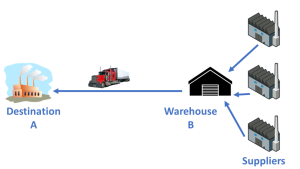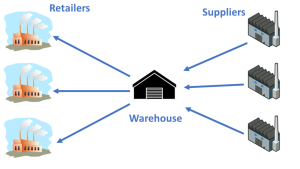15.3 Types of Warehousing
Understanding the different types of warehouses is essential for designing an effective warehouse network. The classification of warehouses varies based on several factors, including their purpose and position in the supply chain. Each type of warehouse serves distinct functions and requires specific design elements to meet its operational needs.
15.3.1 Position-Based Classification

One common way to classify warehouses is by their position in the supply chain:
- Central Distribution Centers (CDCs): CDCs are large facilities that act as the primary hubs in the supply chain. They play a critical role in receiving and redistributing materials. Typically, inbound materials arrive at CDCs in bulk, often on pallets, and are redistributed in a similar manner. For instance, a CDC might receive 20 pallets from a supplier and then allocate these pallets across various Regional Distribution Centers (RDCs). The design of CDCs usually facilitates handling large volumes of goods with efficiency.
- Regional Distribution Centers (RDCs): RDCs are positioned to serve specific geographic areas. They receive products from CDCs, typically on pallets, and are responsible for further distribution within their region. RDCs often break down these bulk shipments into smaller units, such as cartons, to cater to the needs of local retailers or other downstream entities. For example, an RDC might receive 30 pallets, each containing different stock keeping units (SKUs), and reorganize them into assorted pallets to be sent to retailers.
- Fulfillment Centers: These are integral to e-commerce operations, handling the distribution of goods directly to the end consumers within a specific region. Fulfillment centers receive products in various forms, such as pallets or cartons, and redistribute them as individual items or ‘eaches.’ The high number of individual transactions in these centers typically necessitates advanced levels of automation to maintain efficiency and accuracy in order processing.
The movement of products in this network follows a distinct pattern: the journey from the supplier to the CDC is known as the ‘first mile,’ the transit from the CDC to RDCs or fulfillment centers is the ‘middle mile,’ and the delivery from fulfillment centers to the final consumer is referred to as the ‘last mile.’ Each of these stages has unique logistical requirements and challenges, influencing the design and operation of the respective warehouse types.
15.3.2 Task-Based Classification
Warehouses can also be classified based on the dominant tasks they perform, which are defined by the flow of products through the warehouse. This task-based approach categorizes warehouses into several types, each designed to streamline specific logistical processes.
- Consolidation Warehouse: These warehouses are set up to collect materials from multiple suppliers, consolidate these loads, and then dispatch them as a single delivery to a specific location. For example, if a business located in City A sources materials from various suppliers in a distant City B, a consolidation warehouse in City B can be advantageous. Suppliers send goods to this local warehouse in small trucks, where the loads are consolidated and then shipped in larger trailers to the business in City A. This consolidation leads to reduced transportation costs and lower inventory levels compared to each supplier sending individual deliveries.

- Break Bulk Warehouse: The function of a break bulk warehouse is to divide large shipments from one or a few suppliers into smaller loads for delivery to multiple customers. If a supplier in City B has many customers in distant City A, a break bulk warehouse in City A is beneficial. The supplier can use larger, more economical trucks for the journey between Cities B and A, and smaller vehicles for the final delivery from the warehouse to individual customers in City A. This system optimizes transportation efficiency by reducing the need for multiple long-haul trips.

- Mixing Warehouse: Mixing warehouses handle goods from multiple suppliers and redistribute them to various customers. A typical example is the warehouse of a large retailer. For instance, a single warehouse in Southern Florida could supply all Walmart stores in that region. This warehouse receives materials from different suppliers and then redistributes them to the stores. Without a mixing center, direct supply from each of the three suppliers to each of the three retailers would require nine truck routes. The introduction of a mixing center reduces this to six routes, thereby optimizing transportation.

- Cross Dock Warehouse: A specialized form of a mixing center, cross dock warehouses are characterized by their use of advanced technology and automation. These warehouses rapidly redistribute merchandise from multiple suppliers to multiple customer destinations. In a cross-dock warehouse, the time between receiving materials from suppliers and dispatching them to customers can be as short as 3 to 6 hours. This rapid processing minimizes storage time and accelerates the supply chain flow, making it highly efficient for certain types of products and markets.
These task-based warehouse classifications highlight the diverse strategies employed in warehousing to optimize supply chain operations. Each type addresses specific logistical challenges and plays a distinct role in ensuring the efficient movement of goods from suppliers to end consumers.
Consider this problem:
Imagine your manufacturing facility is located in Minneapolis. You have several customers near Columbus, Dayton, and Cincinnati OH. The good news: Dayton is located about halfway between Columbus and Cincinnati, making Dayton an ideal location for your breakbulk facility. You currently ship eight LTL shipments (each weighs about 5,000 pounds) into the region at $500 per shipment. You identify a third-party warehouse operation that is able to unload (and reload) a full truckload for $400. You check with your carrier and discover that the truckload from Minneapolis to Dayton is $1,800. LTL delivery from the breakbulk facility to each customer is $200. Your question: Should you change your delivery model?
15.3.3 Function-Based Classification
Warehouses can also be categorized based on the specific functions they are designed to perform. This function-based classification helps in understanding the specialized requirements and operational nuances of different types of warehouses, each catering to particular storage needs.
- Temperature-Controlled Warehouse: Crucial for storing temperature-sensitive products such as food items, certain chemicals, and pharmaceuticals, these warehouses are equipped with facilities to maintain different temperature zones. Each zone within the warehouse can be set to a specific temperature level to preserve the integrity and quality of the stored goods. This type of warehouse is essential for products that require a controlled environment to prevent spoilage or degradation.
- Tool Rooms: These warehouses are dedicated to storing tools and equipment. Given that the frequency of transactions in tool rooms is typically not high, these facilities often employ high-density racking systems to maximize space utilization. Some tool rooms also incorporate advanced systems like Automated Storage and Retrieval Systems (ASRS) to enhance efficiency and accuracy in storing and retrieving tools.
- Dangerous Goods Warehouse: Specifically designed for the safe storage of hazardous materials, these warehouses cater to items like flammable liquids, explosives, and toxic chemicals. They are equipped with specialized safety features such as fire suppression systems, adequate ventilation, and containment measures for potential leaks or spills. The design and operation of these warehouses adhere to strict safety standards and regulatory requirements.
- Bonded Warehouses: These warehouses are used for the duty-free storage of imported goods pending customs clearance or re-exportation. Bonded warehouses are secured facilities that must comply with specific customs regulations. They are equipped with security measures and procedures to ensure that the stored goods remain under customs control and are not illegally diverted.
As we can see, there is substantial diversity in the types of warehouses, characterized by differences in construction, storage equipment, handling equipment, and more, depending on their position, task, and purpose within the supply chain. It’s crucial to recognize that constructing a warehouse represents a significant investment, and once a facility is designed for a specific function, such as a consolidation center, repurposing it for a different role, like a fulfillment center, can be both challenging and expensive. This underlines the importance of this section: having a thorough understanding of the various types of warehouses and their distinct functionalities is vital.